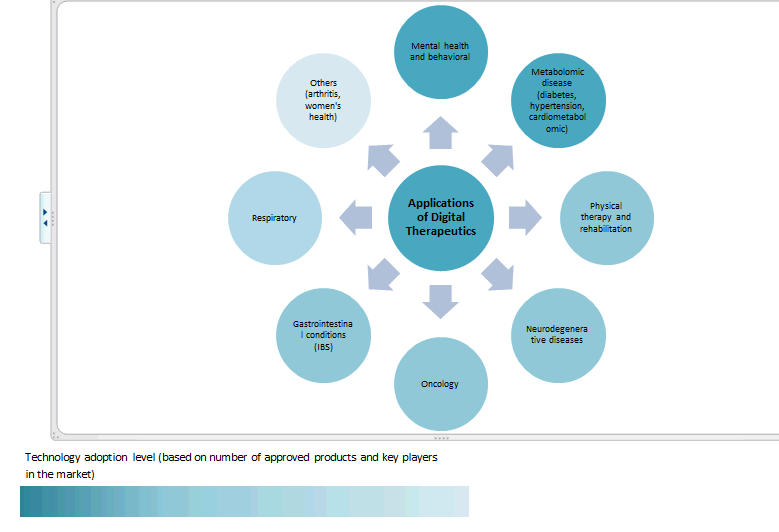Healthcare Industry Embracing Digital Disruption to Improve the Value of Care
The healthcare industry is undoubtedly in the midst of a digital revolution. This transition to digital health is a promising global strategy for addressing the challenges in the healthcare industry. Today, healthcare accessibility and continuity of care are needed. We are witnessing a growth in healthcare consumerism, where patients and consumers are more active and engaged, keen to track their own health, and more open to taking proactive and preventive measures. Digital therapeutics are emerging and disruptive technologies that overcome the limitations of place, time, and availability of healthcare resources.
These software-driven intelligent and accessible therapeutic solutions empower patients and healthcare providers with high-quality, safe, and effective data-driven interventions. Digital therapeutics are the key to shifting from reactive healthcare to proactive holistic care. By leveraging technologies such as artificial intelligence/machine learning (AI/ML), augmented reality/virtual reality (AR/VR), m-health applications, and gamified platforms, these evidence-based digital intervention programs provide remote, on-demand access to personalized therapies for a range of medical conditions.
By analyzing volumes of patient data and by using advanced analytics, AI provides more personalized support. Moreover, by using the predictive analytics capabilities of AI, the patient data is used to create a powerful modeling tool, which anticipates patient prognosis and needs. Virtual and augmented reality work as visualization aids in digital therapies and create an immersive environment. They are helpful in self-guided rehabilitation exercises for pain management and mental health disorders treatment. The use of gamification in digital therapeutic platforms improves and promotes behavioral change in patients; it is applied in chronic disease management platforms and behavioral therapy platforms.
Gamification improves patient engagement and resilience. For chronic conditions such as diabetes, hypertension, and mental health disorders, a behavioral change is required for end-to-end disease management, which pharmacological therapies are unable to deliver. Digital therapeutics are given as monotherapy, such as digital cognitive-behavioral therapies (CBT) for mental health conditions, or they are given as adjunctive therapy with pharmacological agents to improve the effectiveness and management of prescribed intervention, especially for complex indications such as diabetes, obesity, and hypertension.
The COVID-19 pandemic has accelerated the adoption of virtual and home care technologies, boosting the digital therapeutics industry. During the pandemic, digital therapeutics helped tackle the crisis of healthcare worker shortages and limited resources and provided care for those avoiding in-clinic visits. The pandemic also brought in its share of mental health conditions, such as depression, anxiety, and stress, and affordable and accessible digital therapeutics were instrumental in managing these conditions. Following the onset of the COVID-19 pandemic, the digital therapeutics industry saw remarkable growth in private venture funding investments, especially the mental health industry.
COVID-19 also changed the regulatory scenario, making regulators more willing to accept digital therapeutics and proactively developing guidelines and approval pathway regulations for their use. There are examples of several regulators evaluating and enabling changes. Germany was the first country in Europe to facilitate reimbursement for digital therapeutic products. Also, the USFDA developed new guidance documents for improving the availability of digital therapy for mental health conditions. The industry is witnessing more changes and encouraging innovations, with Germany and the US paving the way and more digital therapeutic product approvals from regulatory bodies.
Providing Effective and Precise Care for a Range of Indications
With personalized and evidence-based therapy programs, digital therapeutics show great value across a range of indications. Most digital therapeutics are focused on mental illnesses, followed by digital therapeutics for chronic illnesses, such as diabetes and hypertension.

Digital therapeutics for physical therapy or rehabilitation is more engaging than conventional in-clinic, in-person physical therapy. The immersive environment using AR/VR and the gamified reward-driven platform improve engagement, adherence, and clinical outcomes. Pharmaceutical companies have not had much success with neurodegenerative diseases such as Alzheimer’s or multiple sclerosis. Digital therapeutics is an avenue several pharmaceutical companies are exploring through partnerships and collaborations, such as Boehringer Ingelheim partnering with Click Therapeutics to develop a digital therapeutic for patients with schizophrenia.
Cancer therapy is often long-term and complex and comes with harsh side effects. Oncologists have turned to digital therapies and technologies to improve the outcome of patients receiving cancer therapy. This is another disease industry witnessing collaborations and partnerships between big pharma and digital companies. For example, Voluntis and Bristol-Myers Squibb are developing digital therapeutics for oncology. Gastrointestinal disorder management is associated with behavioral and lifestyle changes, and digital tools enable such changes.
Key Growth Opportunities for Digital Therapeutics
Digital therapeutics offer an attractive value proposition to pharmaceutical companies with beyond-the-pill, holistic care benefits. As clinical evidence of improved health outcomes grows, pharmaceutical companies are embracing digital therapeutics and expanding their investments in digital therapeutics R&D and tech development.
Digital therapeutics will not replace drugs; however, when digital therapy is combined with pharmacotherapy, it improves patient engagement and medication adherence, induces behavioral changes, provides tailored dosages, and educates and guides patients on side effects and self-managing techniques. The industry is seeing an influx of several successful digital therapeutics start-ups, and a few have reached unicorn status quickly. However, pharmaceutical and Medtech companies should capitalize on the growth potential of digital therapeutics through technology convergence. This convergence can be initiated through partnerships and acquisitions with a software technology or digital health company.
Digital therapeutics also offer great value to payers, especially those interested in providing value-based care. Digital therapy offers improved clinical and health economic outcomes by better managing health conditions, reducing disease progression, and lowering overall healthcare costs. It is essential to document efficacy and health outcomes associated with the therapy, so payers are aware of the benefits of digital therapy. It’s also important to highlight the value of the real-world data, which will help analyze population health outcomes and population health management.
Final Word: The Future of Care Demands a Digital Therapeutic-Enabled Care Ecosystem
The future of healthcare will undergo a paradigm shift from a prescriptive to a more predictive and holistic care approach. Digital therapeutics will be used to predict and manage a patient’s future health rather than reacting to symptoms. This emerging treatment approach will undoubtedly have an immense impact, especially with the integration of advanced AI analytics and better healthcare interoperable solutions. This will help reduce the disease burden and be a great value proposition for insurance providers and public health agencies because of the cost savings.

Authored By: – Debarati Sengupta, Industry Analyst, TechVision, Frost & Sullivan
Blog Received on Mail from Frost & Sullivan



![Image used for illustrative purpose [Image by jcomp on Freepik]](https://intlbm.com/wp-content/uploads/2024/03/Image-used-for-illustrative-purpose-Image-by-jcomp-on-Freepik.png)












